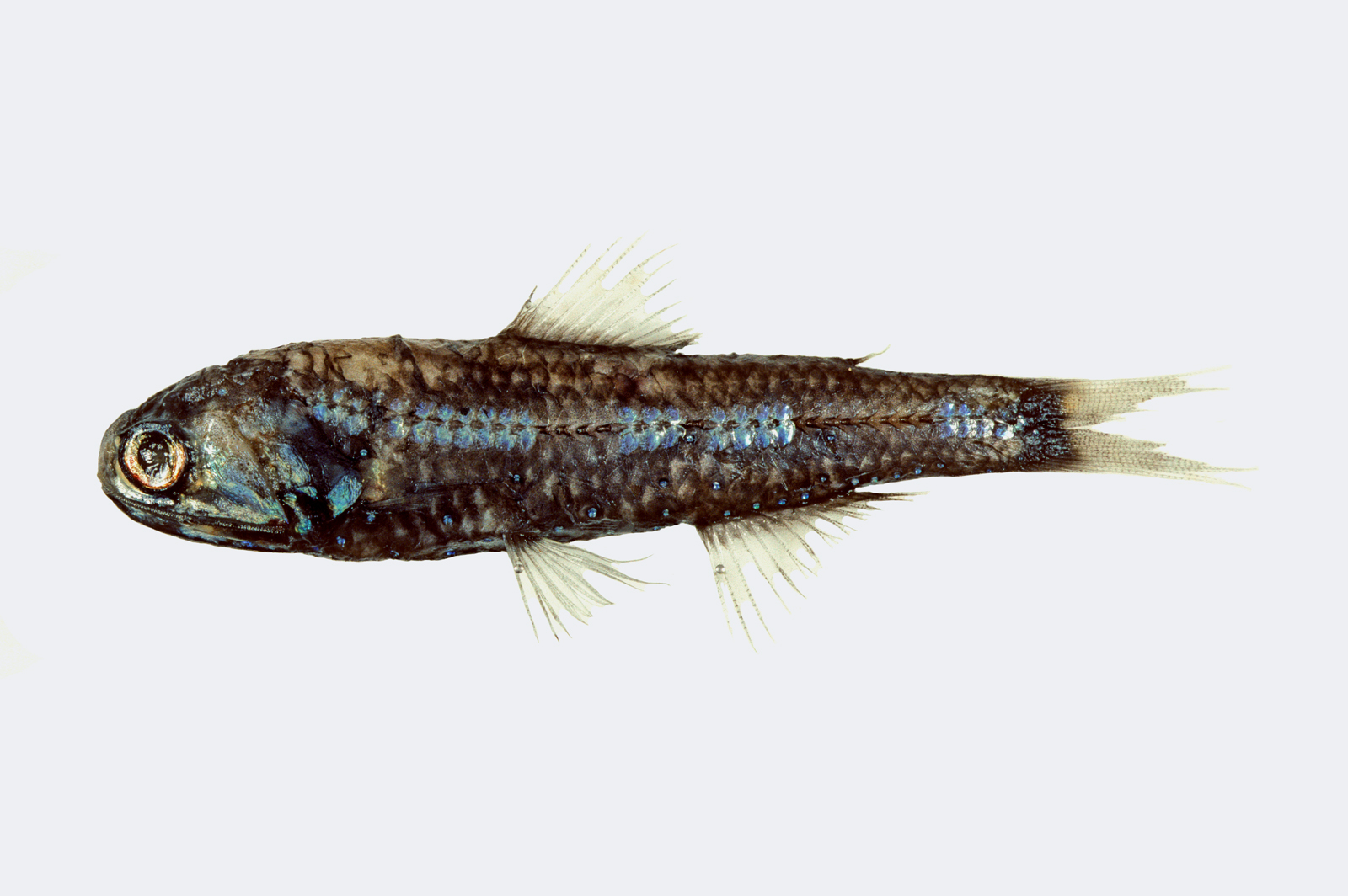Dana Lanternfish, Diaphus danae Tåning 1932

A Dana Lanternfish, Diaphus danae. Source: T. Carter / CSIRO. License: All rights reserved
Dana Lanternfish, Diaphus danae Tåning 1932
More Info
|
Distribution |
A mesopelagic species found in temperate waters over the continental slope in the southwest Pacific. In Australia, the Dana Lanternfish occurs from the Coral Sea south-east of Cairns, Queensland, to the Great Australian Bight off Eucla, Western Australia, including around Tasmania; also recorded off Lord Howe Island. The species is also found in the Tasman Sea across to New Zealand. The Dana Lanternfish is usually sparsely distributed in deep layers of the ocean in the Tasman Sea and off southern Australia. However, the species forms huge spawning aggregations in the western Coral Sea. Spawning occurs at night in the upper-most 350 m of the water column. This lanternfish aggregation provides food for a mass spawning and feeding aggregation of commercially important big-eye and yellowfin tuna. It also attracts whale sharks and other species such as billfishes. |
|
Features |
Dorsal fin 14–16 (usually 15): Anal fin 14–16 (usually 15); Pectoral fin 11–13 (usually 12); Pelvic fin 8 GR 8–10 (usually 8) + 17–20 (usually 19–20) = 28-30 gill rakers; AO photophores 6–7 (usually 6) + 5–6 (usually 5). Vn photophore long, extending posteriorly under eye to level of mid-orbit; So photophore absent: jaws extending ¾ eye diameter or more behind eye; no strongly hooked teeth poteriorly in upper jaw. |
|
Biology |
Data from echosounders has shown that the spawning aggregation occurs at depths between 200-350 m. The lanternfish begin aggregating from 1930 hours and disperse at 0400 hours. |
|
Fisheries |
Lanternfish are an important food source for larger species such as tunas and billfishes. The annual Diaphus danae spawning aggregation in the Coral Sea attracts Big-eye and Yellowfin Tuna. These tuna aggregations have been targeted by commercial fishers for more than 40 years (McPherson 1988) and have been fished by an exclusively domestic fleet since 1987 (Campbell et al. 1997). |
|
Species Citation |
Diaphus danae Tåning, 1932, Vidensk. Meddr. Dansk Naturh. Foren. 94: 140 fig. 13. Type locality: north of New Zealand, 36º23'30"S, 176º26'E. |
|
Author |
Bray, D.J. 2019 |
|
Resources |
Dana Lanternfish, Diaphus danae Tåning 1932
References
Blaber, S.J.M. & Bulman, C.M. 1987. Diets of fishes of the upper continental slope of eastern Tasmania: content, calorific values, dietary overlap and trophic relationships. Marine Biology 95: 345-356. https://doi.org/10.1007/BF00409564
Flynn, A.J. & Paxton, J.R. 2012. Spawning aggregation of the lanternfish Diaphus danae (family Myctophidae) in the north-western Coral Sea and associations with tuna aggregations. Marine and Freshwater Research 63(12): 1255-1271. https://doi.org/10.1071/MF12185
May, J.L. & Blaber, S.J.M. 1989. Benthic and pelagic fish biomass of the upper continental slope off eastern Tasmania. Marine Biology 101: 11–25. https://doi.org/10.1007/BF00393474
McPherson, G. 1988. A possible mechanism for the aggregation of yellowfin and bigeye tuna in the north-western Coral Sea. Technical Report No. FRB88/8, pp. 1–14. (Queensland Fisheries Research Centre: Cairns).
Paxton, J.R. & Bray, D.J. 2008. Family Myctophidae. pp. 270-294. in Gomon. M.F., Bray, D.J. & Kuiter, R.H (eds). Fishes of Australia's Southern Coast. Sydney : Reed New Holland 928 pp.
Robertson, D.A. & Clements, K.D. 2015 89 Family Myctophidae. pp. 613-680 in Roberts, C.D., Stewart, A.L. & Struthers, C.D. The Fishes of New Zealand. Wellington : Te Papa Press Vol. 3 pp. 577-1152.
Tåning, Å.V. 1932. Notes on scopelids from the Dana Expeditions. 1. Videnskabelige Meddelelser fra Dansk Naturhistorisk Forening i Kjøbenhavn 94: 125-146 figs 1-16
Williams, A. & Koslow, J. 1997. Species composition, biomass and vertical distribution of micronekton over the mid-slope region off southern Tasmania, Australia. Marine Biology 130: 259–276. https://doi.org/10.1007/s002270050246
Williams, A., Koslow, J., Terauds, A. & Haskard, K. 2001. Feeding ecology of five fishes from the mid-slope micronekton community off southern Tasmania, Australia. Marine Biology139(6): 1177-1192. https://doi.org/10.1007/s002270100671
Young, J.W., Blaber, S.J.M. & Rose, R. 1987. Reproductive biology of three species of midwater fishes associated with the continental slope of eastern Tasmania, Australia. Marine Biology 95: 323–332. https://doi.org/10.1007/BF004095622
Young, J.W., Lamb, T.D. & Bradford, R.W. 1996. Distribution and community structure of midwater fishes in relation to the subtropical convergence off eastern Tasmania, Australia. Marine Biology 126(4): 571-584. https://doi.org/10.1007/BF00351324




